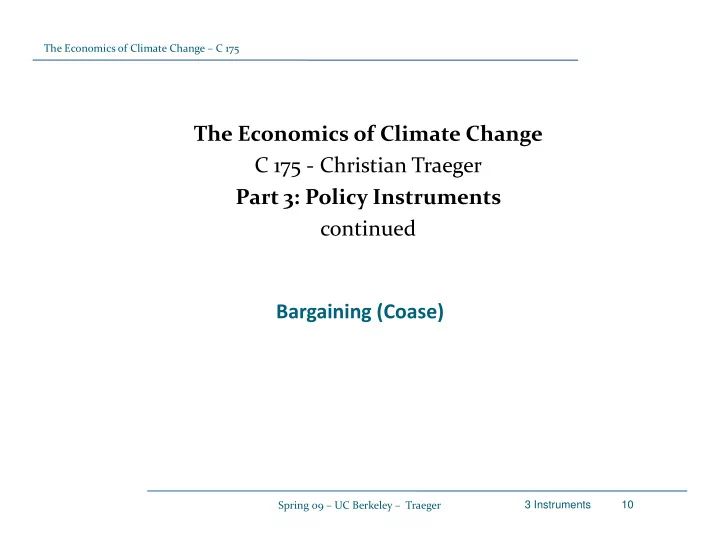

The Economics of Climate Change – C 175 The Economics of Climate Change C 175 ‐ Christian Traeger 75 g Part 3: Policy Instruments continued Bargaining (Coase) Bargaining (Coase) Spring 09 – UC Berkeley – Traeger 3 Instruments 10
The Economics of Climate Change – C 175 Bargaining: the Coase Theorem Ronald Coase (Nobel Price 1991) sees externalities as arising through the absence of property rights: pollution occurs when property rights are ill ‐ defined. If property rights are well ‐ defined, side of market without rights has p p y g g to compensate other side: If atmosphere is a free public good, those who suffer from emissions have to (buy some of the rights from) emitters emissions have to (buy some of the rights from) emitters If agents have right to have clean environment, potential polluters have to compensate (buy some of the rights from) ‘consumers’ of clean environment consumers of clean environment Spring 09 – UC Berkeley – Traeger 3 Instruments 11
The Economics of Climate Change – C 175 Bargaining: the Coase Theorem Coase Theorem, Part 1 I In a competitive economy with complete information and zero i i i h l i f i d transaction costs, the allocation of resources will be Pareto ‐ efficient if all property rights are assigned. The Coase Theorem proposes that economic agents will solve externality problems without intervention, simply by assigning y p , p y y g g property rights Legal rules of entitlement = property rights determine ownership in the economy economy... …and determine the direction of compensating payments if property right is violated. Spring 09 – UC Berkeley – Traeger 3 Instruments 12
The Economics of Climate Change – C 175 Example: Introducing property rights Example: Polluter with benefits from emission level e : B ‐ C(e) Polluter with benefits from emission level e : B C(e) (cost curve convex, same for damage below) Marginal abatement costs MC = ‐ C’(e) Pollutee with income M suffers damages D(e) from emissions, utility: P ll t ith i M ff d D( ) f i i tilit M ‐ D(e) (note: once more quasi linear money metric) Marginal damages MD = D’(e) Social (Pareto) optimum given by M Maximize B ‐ C(e)+U ‐ D(e) i i B C( ) U D( ) Yields D’(e) = ‐ C’(e) Marginal damages = marginal benefits = marginal abatement costs g g g g Spring 09 – UC Berkeley – Traeger 3 Instruments 13
The Economics of Climate Change – C 175 Introducing property rights Right to clean environment: Starting point: zero emissions, e=0 Sta t g po t: e o e ss o s, e 0 Polluter with large abatement costs C(0) , pollutee with large utility U ‐ D(0) Polluter can try to convince pollutee to accept a certain level of emissions if appropriately compensated appropriately compensated. Pollutee demands compensation (Transfers T ) such that U ‐ D(e)+T>=U ‐ D(0) ‐ > minimal transfer: T=D(e) ‐ D(0) Polluter maximizes: B ‐ C(e) ‐ (D(e) ‐ D(0)) Solution: Marginal damages marginal benefits ( D’(e) Solution: Marginal damages = marginal benefits ( D (e) = ‐ C (e) ) C’(e) ) Utility of pollutee: U ‐ D(0) Benefits of polluters: B ‐ C(e) ‐ (D(e) ‐ D(0)) B fi f ll B C( ) (D( ) D( )) Spring 09 – UC Berkeley – Traeger 3 Instruments 14
The Economics of Climate Change – C 175 Introducing property rights Right to pollute: Starting point: emissions as chosen by polluter e*>0 ( ‐ C’(e*)=0) Sta t g po t: e ss o s as c ose by po ute e 0 ( C (e ) 0) Polluter with no abatement cost C(e*) , pollutee suffers large damages D(e*) Pollutee can try to convince polluter to reduce emissions if appropriately compensated compensated. Polluter demands compensation (Transfers T ) such that B ‐ C(e)+T>=B ‐ C(e*) ‐ >minimal transfer: T=C(e) ‐ C(e*) Pollutee maximizes U ‐ D(e) ‐ (C(e) ‐ C(e*)) Solution: Marginal damages = marginal benefits ( D’(e) = ‐ C’(e) ) Utility of pollutee: U ‐ D(e) ‐ (C(e) ‐ C(e*)) Benefits of polluters: B ‐ C(e*) Spring 09 – UC Berkeley – Traeger 3 Instruments 15
The Economics of Climate Change – C 175 Bargaining: the Coase Theorem If there are no income effects (quasi linear money metric utility, i.e. no effect of income on the marginal disutility of the emissions), then Coase Theorem, Part 2 The obtained Pareto ‐ efficient allocation does not depend on the assignment of property rights. i t f t i ht The efficient emission level does not depend on whether polluter The efficient emission level does not depend on whether polluter compensates victim, or whether victim has to compensate polluter for not emitting Wealth distribution however does depend on whom has to pay the Wealth distribution however does depend on whom has to pay the compensation Spring 09 – UC Berkeley – Traeger 3 Instruments 16
The Economics of Climate Change – C 175 Bargaining: the Coase Theorem The practical limitations of the Coase theorem for global warming are: The lack of clear property rights Transaction costs in reaching compensation agreements: often at least one side of market consists of many agents : GHG emissions: billions of polluters GHG emissions: billions of polluters, global warming: millions of victims (and winners) Court may be too costly or not exist (international GHG bargaining!) In sum, the Coase theorem suggests a market solution to the I h C h k l i h externality problem, but there are reasons why the market may not function In practice, Coase solutions are rarely observed Spring 09 – UC Berkeley – Traeger 3 Instruments 17
Recommend
More recommend